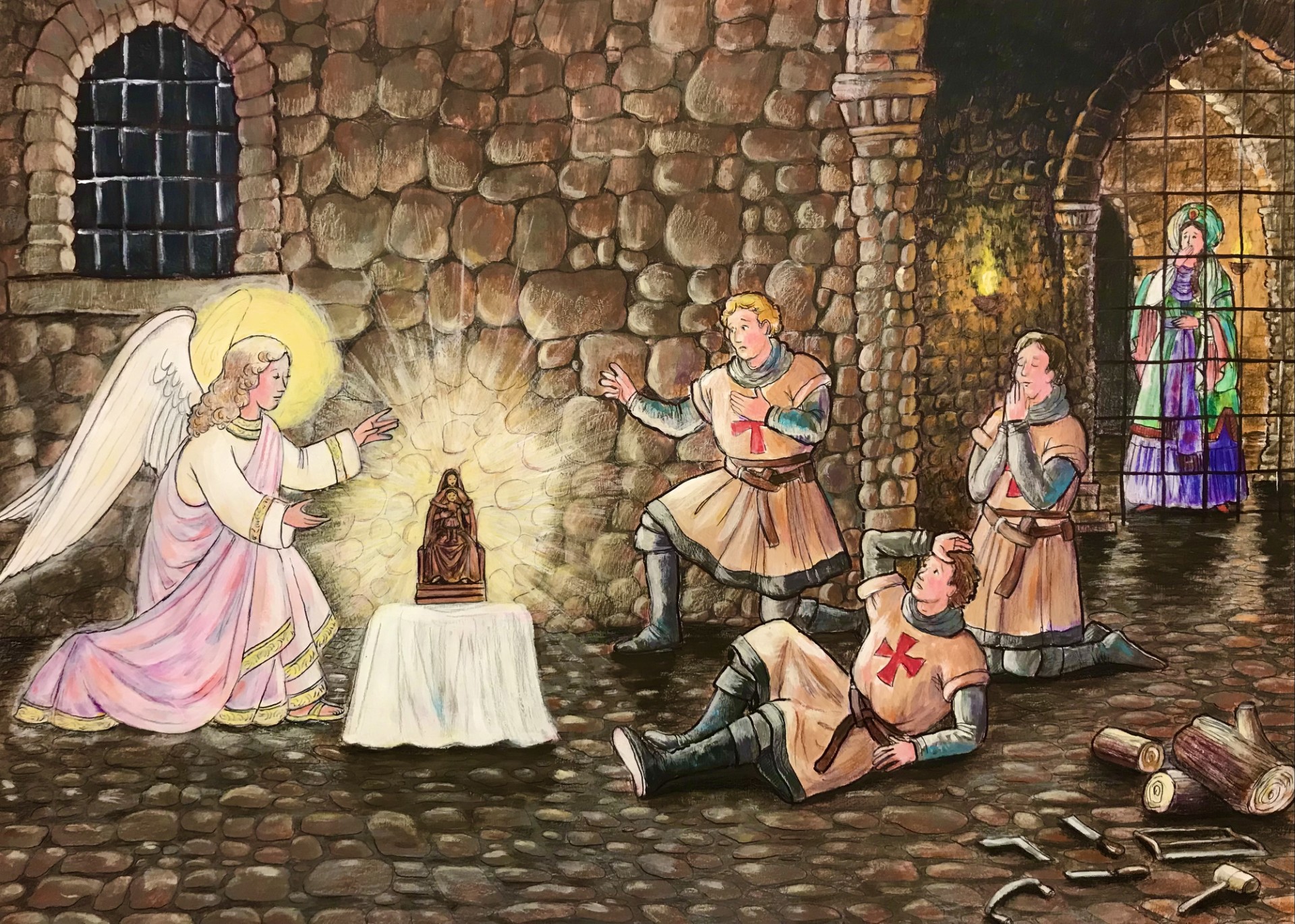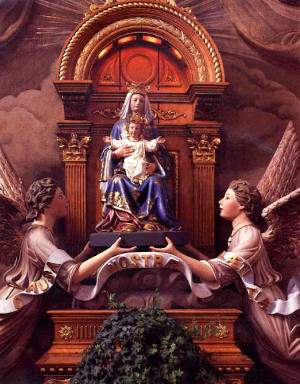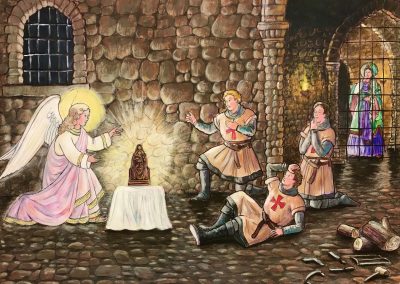The ashes of Our Lady of Liesse
Three crusaders taken prisoner:
In 1134, in the town of Ascalon, 20 kilometers from Jerusalem, the crusaders fight firmly against the Saracens. A troop of valiant crusaders led by Foulques d’Anjou, third king of Jerusalem, defends the tomb of Christ conquered by Godefroy de Bouillon. Hardly, these brave Knights do their job as soldiers with courage that reinforces their quality as Christians. They are, in fact, Knights of the Order of St. John of Jerusalem. Raised by the warm words of the preachers of France, they vowed to join the heroic crusade. Alas! The enemy is outnumbered… A corps of horsemen picks up spurs towards the Crusaders, some are killed, others wounded. Still others, victims of an ambush, fall into the hands of the Muslims. Among these unfortunate victims were three young Frenchmen from the Laon region. They were taken prisoner and soon afterwards to Cairo, Egypt. Locked up in a dark tower, with only bread and water to eat, far from their homeland, with no news of their mother, they are very unhappy! Will they not abandon themselves to despair? Oh no. They call upon God for help, encourage each other, and against bad luck they do good heart. Isn’t their God all-powerful? If it pleases Him to deliver them, all the Muslims of the world will not be able to stop Him. This is precisely what will happen in a wonderful way, but we are not there yet, and our knights will still have to suffer a great deal.
In Egypt, El-Afdhal, delighted at the capture of these Christians, rubbed his hands and said to his marabouts, “Go and see the three knights from me. Try to get them to become Muslims and I will reward you. The envoys enter the prison, and with great intelligence, try to win the sympathy of the young men by first showing them interest. Little by little they came to discuss religion. We can imagine what that conversation was like:
– Become a Muslim and the Sultan will deliver you. – It’s making us buy our freedom too expensive,” answered one of the prisoners. – You can’t put the interests of our immortal soul and those of this fleeting life in parallel,” the other adds. – Even if I have to stay here until death, I will not deny my baptism,” said the third. Hiding his disappointment under a feigned kindness, a marabout said to them: – Do you not know that the Sultan can put you in shackles, torture you, make you die? – Your master will do with us whatever he wants. We are in Christ. On these courageous assertions, the envoys of the Sultan turned their heels and reported to El-Afdhal what was happening: – You will not succeed in making these dogs of Christians apostasize! They fear neither torment nor death.
– Ah! Ah! said the Sultan. That is what we shall see. Having thought long and hard about the means to be employed to overcome the obstinacy of his prisoners, the infidel said to himself: “I have an idea! I will send them my daughter Ismeria. She is pleasant in face, she is not lacking in spirit. What my marabouts did not obtain through discussion, my daughter will obtain through her diplomacy.” And he sent for the princess. This young girl was indeed charming, playful as a child, intelligent, sweet and kind more than any other. Hearing her father entrusting her with this mission, she joyfully replied: “Do not fear anything, my father. I’ll make it my business.”
The Princess who intended to win is defeated:
The daughter of the Sultan, to please her father, goes to prison to win these three brother knights for good. In the dark dungeon, the prisoners lie down. They sadly exchange their thoughts: – When will we see our mother again? – Will we only see her again? – When she learns of our fate, she will die of grief. – Why torment us needlessly? And first of all, can we guess what the future holds for us? – Let’s ask God to help us – Yes, yes. Let us also pray to his mother, and let us trust in her. Suddenly, the prisoners are intrigued by what is happening in the corridor. What is that sound of footsteps? This is not the time for our jailers to visit. Among those male voices, we hear a woman’s voice. What does it mean? The young men are soon fixated when they see the charming princess enter near them. The introductions were not long: – I am the daughter of the Sultan. You are not unaware that my father, displeased with your attachment to Christianity, has resolved your loss. I have come to deliver you, if you consent to what he desires. And, showing a purse full of gold: – See, this is yours if you consent to renounce Christ. Ismailia is completely ignorant of the Christian religion; she knows that Muslims do not love Christians, that her father hates them. But he is certainly right, how could he be wrong? These are all his arguments. She believes in God the Creator, since Mohammed believes in Him. The simplicity of the princess, her sincerity, touches the hearts of the prisoners. More moved than alarmed, they say to her: – Do you know what you are asking for? … No doubt, you are unaware that this God, whom you worship as we do, has loved us so much that he sent his Son Jesus to the earth and that he has chosen a Mother among us? It is the Virgin Mary. Jesus, Son of God, whom you also call prophet after Mohammed, taught us what we had to do to get to heaven. He allowed himself to be crucified for us. And you would have us betray him? The astonished princess listens attentively to this first catechism lesson. She cannot believe her ears. She questions: – You speak to me about Jesus and Mary, I would like to see them – You will see them later if you become a Christian.
– Couldn’t you at least sculpt an image for me? Alas! Prisoners are soldiers, not sculptors. Inspired from above, they answer: – Bring us wood and tools. Isermeria promises them this.
The Embarrassment of the Knights:
While the Princess was returning to her father’s palace in a dream, the knights said to each other, “How shall we carve this statue for her? Let’s ask the Virgin Mary to help us out of this embarrassment so that this young girl may one day become a Christian. In possession of the wood and the instruments to work with, they remained dreamers. – Bah! said one of them. Tomorrow we will see how to get out of it. The night has come, let us sleep in peace. “By night the Angel of God brought the image of the Virgin into this place.
O marvelous wonder! While her three servants were resting under the protection of their guardian angels, “the Queen of Heaven brought to them her radiant image of piety and sculpted by a miracle”. This is what historians say. The statue was small, made of black wood, and represented the Virgin holding her Son standing on her knees.
The marvelous vision:
When they awoke, the prisoners were surrounded by a dazzling light that glowed from the miraculous statue. A heavenly scent emanated from this wood from the sky. All three fell to their knees, worshipping this holy image with extraordinary joy. At dawn, the Sultan’s daughter came to the prison. At the sight of this spectacle, she remained frozen on the spot, prey to an unspeakable emotion. The Knights told her what had happened, their embarrassment, their prayer, the miracle. Ismérie cried out: – Certainly, only God could have done that. Would your religion be the true one? Give me your statue and I will become a Christian. The Crusaders found it difficult to part with this marvelous image. However, thinking that the conversion of the Princess might be the fruit of their sacrifice, they said to her: “Take it, but only on condition that it is not desecrated. Ismailia, hiding the precious object under her ample clothes and veils, joyfully took it to her apartments where she hid it.
Our Lady appears to Ismeria:
The following night, Our Lady appeared to him: – “Trust me, I have prayed for you my Son and Lord, he has deigned to choose you as his faithful and beloved servant. You will deliver my three devout knights from their prison, you will be baptized, through you France will be enriched with an incomparable treasure, through you she will receive countless graces, through you my name will become famous and later I will receive you forever in my paradise”.
As a result of this grace, Ismeria resolved to become Christian, and to become Christian, to leave the land of the unbelievers. To save the three knights from the dungeon, she studied an escape plan and submitted it to them. How could the guards have mistrusted the Sultan’s daughter? In the middle of the night, while they were sleeping, the brave girl smuggled the prisoners out. Wearing the miraculous statue under her cloak, she fled with them into the darkness. Once this is done, the hasty little group leaves Cairo in a hurry for fear of being pursued. All four run into each other in front of the Nile barrier. How do they cross it? Legend has it that a boat was nearby. Quickly, the escapees get off it and cross to the other side. Without lingering, they continue on their way at such a speed that, when they get tired, they have to stop. They lay down at the entrance of a wood. One after the other, the fugitives fall into a deep sleep.
Waking up in France:
At dawn, the young girl woke up first, rubbed her eyes, no longer recognized the landscape of the banks of the Nile. She considered, in amazement, a small fountain that flowed not far from her. A shepherd was leading his flock, accompanied by bagpipes. At the sound of his song, the young men awoke. Their amazement equaled that of Ismeria. They questioned the shepherd:
-Where are we?
– In Liance, near the castle of Marchais, not far from Laon. Liance was a hamlet lost in the middle of woods and swamps. Liance in the 15th century changed its name to Liesse which means “JOY” because the Virgin Mary, through her favours, filled the pilgrims with joy.
– How! says one of the crusaders, but I am the lord. O delicacy of the Blessed Virgin! The village of Marchais; it was the place where the mother of the crusaders lived. While conversing with the shepherd, the three young men were on their way to their family castle. Their joy was such that they forgot the princess. The princess, who did not see them return, had a moment of fright. Already, she saw herself alone in this unknown country. So she began to run after the knights with all the speed of her legs, forgetting in her turn, near the fountain, the statue of the Virgin. The girl joined the small group and continued walking with them. The travelers had already traveled a long way when they cried out: – “My God! the statue!”. Turning around, they all returned together to the fountain, and found the Virgin partly covered with water. The Princess quickly pulled it out of the water and took it, and all of them joyfully returned to the castle. As they walked, they confided in each other: – “The Virgin Mary saved us. What will we do to show our gratitude to her? What if we built her a chapel?” The ground was swampy, they were always advancing, hoping to find solid ground further on. They crossed a garden. At this point, the statue became heavy, heavy… Impossible to continue carrying it. The travelers understood the meaning of this new prodigy: – It is here that the Blessed Virgin wants to have her chapel. She will have it. We vow it. Immediately the statue returned to its normal weight. The young men, continuing on their way, said to each other: “Our mother will die of joy when she sees us again. She believes we are prisoners in Egypt. Let’s give her a gentle warning, so that she can prepare herself for the emotion of seeing us again.” They sent a messenger to her, and in the meantime, lay down in the shade of the tall trees. When the mother was warned, they all ran to meet her. In the midst of the outpouring of the goodbye, they gave thanks to the Virgin for having granted them such joy. What were their sufferings in Egypt? Hardly did they remember them! They were in France, at home, protected by heaven in a magnificent way. Oh yes, truly, they lived their lives in thanksgiving.
The statue becomes heavy:
The travelers, we saw, had woken up near a fountain. They resolved to build a small chapel there, too, to house the statue. Why did they place the holy image there, when the Virgin Mary had signified her desire to be honored in the garden where it had become so heavy? This garden belonged to a private person, were the knights reluctant to ask the owner’s permission? We do not know.
The statue was piously placed near the fountain and the young men returned home. The next day, they returned to visit it. O astonishment! It had disappeared. What had become of it? With pain, they searched for it. They found her in the garden where she had become so heavy. The knights decided that the Virgin wanted to remain there, in the same place where they had first promised her a sanctuary. They took the necessary steps, and while waiting for a beautiful chapel to be built, they housed the statue in a small niche made of branches.
What became of the Knights afterwards:
According to a 16th century tradition, the knights were sons of William I, lord of Eppes, who made a donation to the abbey of Saint-Martin de Laon. Their names were Jean, Hector and Henri. They are called in turn the knights of Eppes, the knights of Saint John of Jerusalem or of Malta. When their mission was over, it is believed that they returned to a house of their Order.
As for Princess Ismérie, she was instructed in the Christian religion, abjured the Koran, received, with the name of Mary, the baptism from the hands of the Bishop of Laon, Barthélemy de Vir, on September 8, 1134. She lived holy beside the mother of the knights at Marchais, died young and was buried in the shrine.
The ashes of the statue in Montreal :
But the French Revolution broke out, which spared neither the town nor the church of Liesse in its fury. Of the precious statue thrown into the fire, only charred debris remained, which was fortunately collected. And we can say that it was twice reborn from its ashes, at least by the virtue that this miraculous dust communicated to the statues that successively replaced it: a first, in which the coals, preciously preserved until the restoration of the cult, were introduced; then a new statue inaugurated at the coronation of Notre-Dame-de-Liesse, in France, and which also contains a part of it. The first one, almost entirely rebuilt by an artist, is the one that was given to the Jesuits of Canada. This treasure was brought to the Gesu of Montreal in 1877 by Father François de Sales Cazeau. From then on, the church became an official place of pilgrimage dedicated to Our Lady.
Sources:
Historical documents from the 16th century bear witness to this, just have a look at them. Here are these documents: Annals of the Order of the Knights of Saint John of Jerusalem.
-From the year 1146, Melchior Bandini tells us about the origins of Our Lady of Liesse. Bosio, a century later, has preserved these pages for us. A precious inscription, that of 1134, the year in which history places the miracle, was providentially found in 1721.
– A letter from Clement VII, dated May 28, 1384, from Avignon, says that “in the chapel of Our Lady of Liesse, Our Lord Jesus Christ, at the prayer of the Virgin Mary, performed so many miracles that people came from all parts of the world. And he grants indulgences to the pilgrims.
– The story of Our Lady of Liesse, according to the oldest known text, by the Count of Hennezel d’Ormois.




